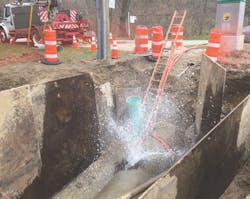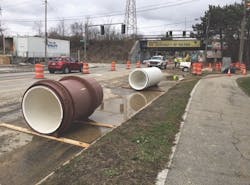About the author:
Mike Leathers is president of Thompson Pipe Group – Pressure. Leathers can be reached at [email protected].
How do we make valid selections when it comes to picking the right pipe material for a specific application? What are the criteria we use? Can we turn to someone for expert help? How do we know our choices are the right ones? When it comes to pipe and you need good information fast, who do you turn to? Earlier this year, in Toledo, Ohio, an all-too-common accident occurred involving a pressure water pipe. It clearly demonstrated how the choice of the right partner can be key to the rapid restoration of service.
Making choices is something we have to do all the time. We all began making choices as children. Play outside or stay in and read a book? This movie or that one? Much of growing up and becoming a responsible adult centers on learning to make a never-ending series of choices, and making the right choices and not the wrong ones. As children, though, we probably have the guidance of parents, teachers and adults.
Of course, all through life, some choices are more important than others. Choosing a spouse or deciding on which dessert to order from a menu; deciding on a career or picking out a pair of gloves; opting for the blue car or the red one. Some choices have serious consequences, while others do not. Often, we seek advice or help whether that is through a friend, a family member or an expert. As professionals and engineers, the choices we make can sometimes have long-lasting consequences.
This Pipe or That One
When it comes to selecting pipe material, we may have to make decisions that impact infrastructural longevity, safety and cost-effectivity far into the future. Water, wastewater and drainage systems often have to last for half a century or more—in some cases even longer. Imagine people in, say, the year 2100 still living with the consequences of choices that you are making today.
So how does a design engineer, owner or municipal contractor make the right choice when it comes to pipe material? To begin with, there are design specifications and guidelines. There are the years of training and experience behind the decision. There is tradition to fall back on—that is how we have always done it. And there are the usual selection criteria, such as price and availability.
Evaluating Risks & Options
In order to make the best decision when it comes to pipe material, it is wise to begin by evaluating needs, resources, risks and options. This sounds straightforward, but it can be extremely complicated. There are many questions that must be answered before a good choice can be made, including:
- What job does the pipe have to accomplish?
- What are the specifications laid down for the project?
- Is this a rehab, an addition or a new line?
- What are the details of the existing line?
- Has the installation method been selected?
- Are there industry standards that apply?
- What is the product availability?
- What are the estimated lifetime costs?
The list goes on and on. Your choice also may have to factor in procurement guidelines or procedures, political considerations and more.
Obviously, any kind of expert help probably would be helpful. So where can you turn to get independent, non-partisan help from a source that really knows all aspects of the pipe industry, and who can be trusted to hold your best interests at the forefront, rather than steering you towards a specific product that they happen to manufacture?
Selecting the right pipe for a job requires an understanding of the soil chemistry, water table, historical data and pressure requirements among many others.
When Accidents Happen
Even the best pipe selection in the world is no guarantee that the unexpected won’t happen. Pipes can be damaged by natural disasters or by other unforseeable events. And when disaster strikes, you need somewhere to turn for help.
An emergency pipe burst in Toledo was caused when an electrical contractor, who was performing a vertical boring operation, mistakenly drilled into a concrete pressure pipe. Luckily, the city water department and emergency utility contractor knew where to turn. Thompson Pipe Group provided historical design records, repair options, necessary parts and emergency field assistance on short notice.
Sometimes, challenges during a repair can appear. In this case, the pipe needed to be vented to reduce pressure. The procedure of venting and draining a section of the line had to be vetted. Thompson Pipe Group was on hand to assist with the assessment and necessary procedure.
Know Your Options
Perhaps the most important contribution Thompson Pipe Group makes to design engineers, contractors and owners is to provide viable options, which can form the basis of an informed decision. This may be about pipe selection, installation procedures, historical data and design records, or hands-on assistance. Making the right choices is so fundamental to the successful conclusion of any project, and understanding all the options is essential to landing on the right choice.
Understanding the options is probably more important today than it has ever been. The recent rise in steel prices, for example, can impact overall project costs and even endanger availability. This makes the improved prestressed concrete cylinder pipe (PCCP) alternatives even more attractive than before. The PCCP produced today is much improved when compared to the product that was marketed back in the 1970s, but the pipe still has to carry the disadvantage of a sullied reputation, however unjustified this is today. When Thompson provides pipe material options for consideration, it does so with the understanding that modern PCCP is as reliable as traditional steel, and in many cases, it is more affordable.
No Single Choice Is Always the Right One
Picking the right pipe for a specific installation requires a world of knowledge. There are simply so many variables to be considered. What about soil chemistry, water table, pressure requirements, existing infrastructure, historical data, local conditions and regulations—the list goes on and on. Finally, of course, there is cost. The design engineer must consider a world of variables and land on the right choice, confident that the selection will be the right one, now and for years to come. Even with long training and experience, this can be a somewhat daunting task. Luckily, there is help to be had.

